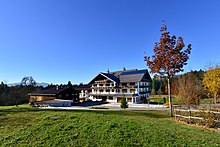Rossbad (medicinal bath)
The Rossbad (formerly also: Rassbad , 654 m above sea level ) was a spa and inn (today still a spa hotel) between Krumbach and Langenegg and is located in the Rossbad district of the municipality of Krumbach in Vorarlberg ( Austria ) in today's Rossbad nature reserve .
Name derivation
In Alemannic or also poetically, horse is used for domestic horse . According to legend, the name "Rossbad" comes from an incident in 1705 when a lame horse stepped into the water of the healing spring and was healed as a result. The Rossbad spa also gave its name to the surrounding Rossbad nature reserve .
history

The spa became famous during the Thirty Years' War . The Vogt of Bregenz, Wernher von Raitnau, is said to have discovered the spring in 1640 on a hunting trip. A chapel was built in the 17th century, but it was demolished in 1825. The Rossbad was sold several times in the 19th century. Konrad Bilgeri bought it in 1808 and sold it to Anton Raidel, who resold it to Johann Kaspar Steurer in 1834. In 1851 Josef Nussbaumer and his wife Katharina Schnell (vulgo: Rossbadwible ) became owners, but sold it to Kaspar Mang in 1855, who passed it on to Martin Fink in 1857. In 1883 Konrad Steurer and in 1920 Philipp Fink acquired the Rossbad. When it was sold to Xaver Nussbaumer in 1936, the Rossbad was converted into a modern spa facility. The bathroom is still owned by this family (now Schwärzler). Kneipp therapies, medicinal baths, massages, etc. have also been offered since 1958.
Bathing and healing spring
The healing spring is a cold, alkaline sulfur spring, similar to those in Bad Haslach in Dornbirn or in the sulfur bath in Hohenems or in Bad Kehlegg in Dornbirn.
The peak of the spa was at the end of the 18th and 19th centuries.
Geography / topography
The Rossbad is about 3.4 km as the crow flies southwest of the village center of Krumbach. The municipal boundary of Langenegg with the Badgraben (border water) is about 200 m west of the hotel.
literature
- Werner Vogt: Old health spas in Vorarlberg a journey through the Vorarlberg bathing landscape. Verlag Benvenuti, Feldkirch 2001, ISBN 3-901522-07-7 .
- Christoph Vallaster: Small Vorarlberg spa book. Book Spezial Verlag, Dornbirn 1984, ISBN 3-900496-03-3 .
- Josef Zehenter, Mineralquellen Vorarlberg , Innsbruck 1895, Online Vorarlberger Landesmuseum .
Web links
Individual evidence
- ^ Christoph Vallaster: Kleines Vorarlberger Heilbäderbuch , p. 43; Ferdinandeum magazine for Tyrol and Vorarlberg, Innsbruck 1895, p. 170.
- ^ Christoph Vallaster: Kleines Vorarlberger Heilbäderbuch , p. 43; Josef Zehenter, Mineralquellen Vorarlberg , p. 170.
- ↑ Christoph Vallaster: Kleines Vorarlberger Heilbäderbuch , p. 43 ff.
- ↑ Christoph Vallaster: Kleines Vorarlberger Heilbäderbuch , p. 45.
- ↑ Eduard Jos Koch in “ Treatise on mineral springs in general scientific relation and description of all baths and wells known in the Austrian monarchy ”, Vienna 1843, Pichler, Volume 1, p. 180; and O. Wigand, “ Archiv der Heilkunde ”, 1876, Volume 17, p. 108; Christoph Vallaster, Kleines Vorarlberger Heilbäderbuch , p. 21; August Härdtl, “The healing springs and health resorts of the Austrian imperial state and Upper Italy”, Vienna 1862, p. 35.
- ↑ Christoph Vallaster: Kleines Vorarlberger Heilbäderbuch , p. 43. See also the statistical yearbook for the year 1871 of the KK Statistischen Central-Commission, Vienna 1873, p. 563, in which only nine domestic persons are listed as bathers for 1871 and none foreign bathers.
- ↑ The Badgraben drains into the Weißach and from there into the Bregenz Ach and Lake Constance .
Coordinates: 47 ° 28 ′ 42.4 " N , 9 ° 53 ′ 25.4" E
